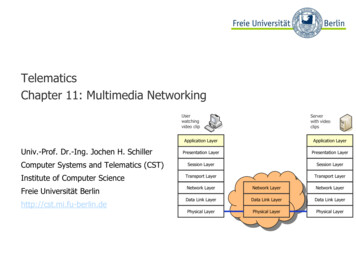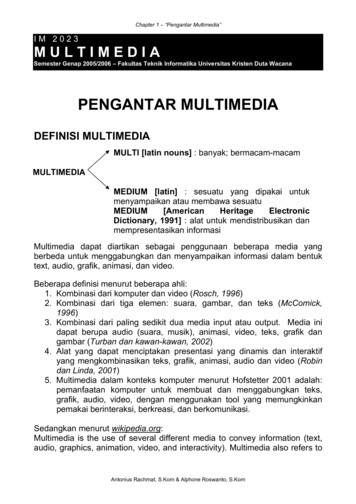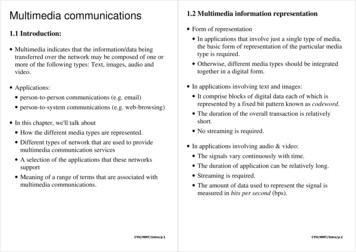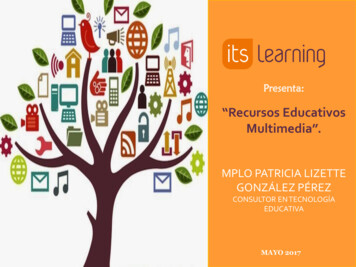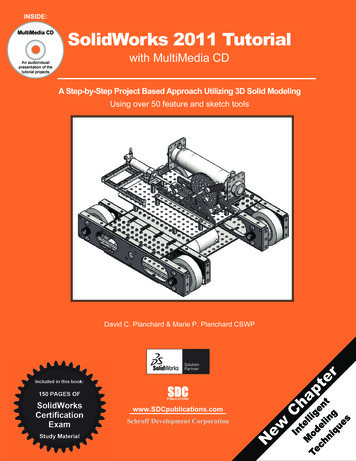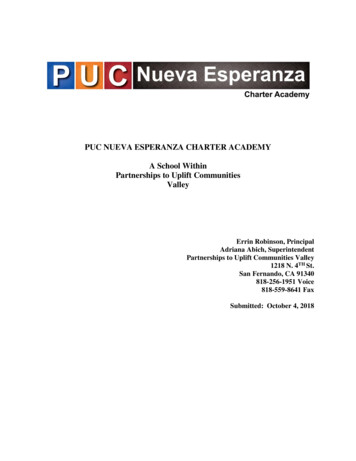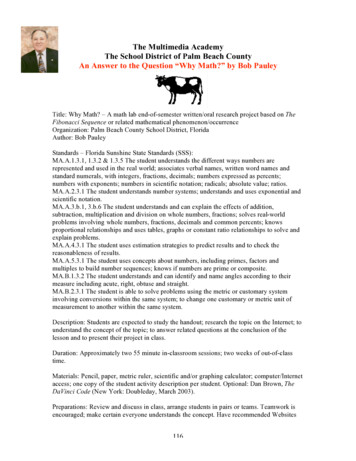
Transcription
The Multimedia AcademyThe School District of Palm Beach CountyAn Answer to the Question “Why Math?” by Bob PauleyTitle: Why Math? – A math lab end-of-semester written/oral research project based on TheFibonacci Sequence or related mathematical phenomenon/occurrenceOrganization: Palm Beach County School District, FloridaAuthor: Bob PauleyStandards – Florida Sunshine State Standards (SSS):MA.A.1.3.1, 1.3.2 & 1.3.5 The student understands the different ways numbers arerepresented and used in the real world; associates verbal names, written word names andstandard numerals, with integers, fractions, decimals; numbers expressed as percents;numbers with exponents; numbers in scientific notation; radicals; absolute value; ratios.MA.A.2.3.1 The student understands number systems; understands and uses exponential andscientific notation.MA.A.3.b.1, 3.b.6 The student understands and can explain the effects of addition,subtraction, multiplication and division on whole numbers, fractions; solves real-worldproblems involving whole numbers, fractions, decimals and common percents; knowsproportional relationships and uses tables, graphs or constant ratio relationships to solve andexplain problems.MA.A.4.3.1 The student uses estimation strategies to predict results and to check thereasonableness of results.MA.A.5.3.1 The student uses concepts about numbers, including primes, factors andmultiples to build number sequences; knows if numbers are prime or composite.MA.B.1.3.2 The student understands and can identify and name angles according to theirmeasure including acute, right, obtuse and straight.MA.B.2.3.1 The student is able to solve problems using the metric or customary systeminvolving conversions within the same system; to change one customary or metric unit ofmeasurement to another within the same system.Description: Students are expected to study the handout; research the topic on the Internet; tounderstand the concept of the topic; to answer related questions at the conclusion of thelesson and to present their project in class.Duration: Approximately two 55 minute in-classroom sessions; two weeks of out-of-classtime.Materials: Pencil, paper, metric ruler, scientific and/or graphing calculator; computer/Internetaccess; one copy of the student activity description per student. Optional: Dan Brown, TheDaVinci Code (New York: Doubleday, March 2003).Preparations: Review and discuss in class, arrange students in pairs or teams. Teamwork isencouraged; make certain everyone understands the concept. Have recommended Websites116
available and assure student readiness. Students will be informed of the magnitude of theproject, which will represent 20% of their semester grade. They will be advised of ampleteacher and aide availability for assistance and/or tutoring if necessary.Procedures: Read the handout; study the subject matter online; share and compare ideas;prepare the 10-12 page project in Microsoft PowerPoint, Publisher or Word format; preparean oral team presentation of 8-10 minutes in class. A computer, media projector and/oroverhead projector will be provided.Project: Why Math? The Leonardo Fibonacci StoryIntroduction – Leonardo Fibonacci (pronounced f!-b"-na’-ch!) lived during the years1173 – 1244. That would make him about 830 years old by now – dates brought to you,incidentally, by mathematics. When Fibonacci was alive he made an amazing discovery inAlgiers: Mathematics has magical properties! He was from Pisa, Italy where construction of afamous tower had begun on the eve of his birth. The tower, which took 200 years to build,leans 1/20 of an inch farther every year, 1.3 mm, but that’s another story. Galileo droppedapples from that tower and created formulae for gravity, but that’s yet another story. Math isthe language of science that made all these facts and figures possible.Consider this: recently we saw an eclipse, a lunar eclipse, where the earth’s shadowpasses across the moon. A solar eclipse is one that occurs when the moon passes in front ofearth, blocking out the sun. Thales, an ancient Greek mathematician, correctly predicted asolar eclipse on May 28, 585 BC – how cool is that? He did lots of other neat things relatingto mathematics and is therefore known as the father of mathematics. But how do we know itwas on May 28th, almost 600 years before the AD calendar began? For that we havemathematics and mathematicians to thank. Mathematics affects us in many ways.Euclid, the father of geometry, and Diophantus, the father of algebra, came beforeFibonacci and helped to define this thing we call conventional mathematics. From ancientGreece to China to India to Arabia, this wondrous thing called mathematics fascinated earlyscientists and philosophers. If, indeed, they were remarkable it is because they stood on theshoulders of giants: those who came earlier and created the stepping stones for them.Fibonacci came up with an amazing discovery, a sequence of numbers that define almosteverything that goes on in nature now called The Fibonacci Sequence. Check it out onacci/fibnat.html#bees.117
The Fibonacci Sequence is called The Golden Ratio because of its ability to define theheretofore misunderstood architecture of nature. Consider Pascal’s Triangle – a greatdisplay of Fibonacci’s numbers from the year 1201. Note that each number is the sum ofthe two numbers above it. Is this arrangement good for anything at all? What does it tellus? Have a look at this self-explanatory Website http://www.krysstal.com/binomial.htmland discover several important uses. One, for example, I call Gimme five:Say we have five books and we need to know how many ways there are of uschoosing r books from a total of n books. The number of ways of selecting r objects fromna total of n is written as CrSo the selections can be written mathematically as follows:There is one way to select no books from 55C0 1There are 5 ways of selecting 1 book from 55C1 5There are 10 ways of selecting 2 books from 55C2 10There are 10 ways of selecting 3 books from 55C3 10There are 5 ways of selecting 4 books from 55C4 5There is one way to select 5 books from 55C5 1Wow! We can go down to the nth row on Pascal’s triangle (beginning with row 0) andwe go r spaces to the right for the answer to our query. That’s pretty cool, huh? Can youappreciate this funny looking triangle a little more now? I know I can. Note that we cantake the sum of the numbers of each row beginning at the top (row zero) and get 20, 21, 22and so forth as we go down the rows, also pretty neat stuff, this numbers game calledmathematics. But wait, there’s more – much more!Fibonacci put his numbers in a row that looks like: 1, 1, 2, 3, 5, 8, 13, 21, 34, 55 The first two numbers add up to the third. The fourth number is the sum of the secondand third number, etc. The Website http://people.bath.ac.uk/ma2gac/gemma2.htmexplains where the numbers come from:Fibonacci Rabbits – We begin with one pair of immature rabbits and wait onemonth, their maturity cycle. The rabbits then conceive the notion of another pair ofimmature rabbits, but it takes one more month for them to realize the birth of that notion.Therefore, at month 0 there was 1 pair of rabbits. At the end of month 1, there was stilljust that same 1 pair of rabbits. By the end of month two, however, there was a new pairof rabbits (a boy and a girl rabbit), now 2 pairs.The first pair conceives another pair of rabbits that require one month to birth. Now,at the end of month 3 there are 3 pair of rabbits. At this point the first pair of rabbitsconceives another pair of rabbits, as do their first pair of offspring. By the end of month 4there are 5 pairs of rabbits, 3 of which may now prepare for another blessed event at theend of the next 30 days. The following month the 3 pairs of rabbits give birth to another 3pairs for a total of 8 pairs. There are 5 fertile pairs at this juncture, all of which will give118
birth after an additional 30 days, making 13 pairs in total. Next there would be 21 pairs,then 34, then 55 and on and on and on The number of pairs of rabbits in the field at the start of each monthis 1, 1, 2, 3, 5, 8, 13, 21, 34, .Fibonacci Flowers – Most plants have a Fibonacci number of petals as shown in theWebsite: http://people.bath.ac.uk/ma2gac/gemma5.htm. 3 petals: lily, iris5 petals: buttercup, wildrose, larkspur, aquiligia8 petals: delphiniums13 petals: ragwort, corn marigold, cineraria21 petals: aster, black-eyed susan, chicory34 petals: plantain, pyrethrum55 petals: michaelmas89 petals: daisies119
In trees and plants the branches shoot off in Fibonacci fashion. Pine cones, seeds andthe heads of flowers grow in spiral Fibonacci patterns, most always maintaining thegolden ratio Fibonacci calculated to be 1.618. carried out to 1000 decimal places. Ifthere are 1.618. leaves per turn it gives flowers or petals the best possible exposure toinsects to attract them for pollination, and the best possible exposure to sunlight. Thewhole of the plant seems to produce its leaves, flowerhead petals and then seeds basedupon the golden ratio – the Fibonacci Number.In snails their shells form in Fibonacci patterns. How amazing is that!!!Honeybees and Fibonacci – There are over 30,000 species of bees and in most ofthem the bees live solitary lives. The one most of us know best is the honeybee and it,unusually, lives in a colony called a hive and they have an unusual family tree. In fact,there are many unusual features of honeybees and the Fibonacci numbers count to reveala honeybee's ancestors. First, some unusual facts about honeybees such as: not all ofthem have two parents! The family trees of honeybees multiply in Fibonacci fashion120
because male bees are born from an unfertilized queen bee and have no father, femalebees require both a mother and father bee.In a colony of honeybees there is one special female called the queen.There are many worker bees who are female too but unlike the queen bee, they produceno eggs.There are some drone bees who are male and do no work. Males are produced by thequeen's unfertilized eggs, so male bees only have a mother but no father!All the females are produced when the queen has mated with a male and so have twoparents. Females usually end up as worker bees but some are fed with a special substancecalled royal jelly which makes them grow into queens ready to go off to start a newcolony when the bees form a swarm and leave their home (a hive) in search of a place tobuild a new nest.So female bees have 2 parents, a male and a female whereas male bees have just oneparent, a female. Let's look at the family tree of a male drone bee.1. He had 1 parent, a female.2. He has 2 grand-parents, since his mother had two parents, a male and a female.3. He has 3 great-grand-parents: his grand-mother had two parents but his grandfather had only one.4. How many great-great-grand parents did he have?Again we see the Fibonacci numbers:Number ofParentsof a MALE bee:of a FEMALE bee:12Grandparents23Great GPGtGtGP3558GtGtGtGP813Other absolutely unbelievable applications of Fibonacci’s Golden Ratio lies innature’s architecture. For short, we identify the ratio using the Greek letter Phi (!).121
Fractals – There is a lot of interest among mathematicians currently in Fractals. AFractal is a shape or sequence or system that is infinite and contains a copy of it withinitself. Such use of the golden ratio or its series of numbers are called self-replicating orself-generating. Applying the Fibonacci numbers in our project requires the use offractals in ever descending (or ascending) concentric fashion. The procedures shown hereare excellent examples of utilizing fractals.Fibonacci Fingers? – Look at your own hand:You have .2532hands each of which has .fingers, each of which has .parts separated by .knucklesHowever, if you measure the lengths of the bones in your finger (best seen by slightlybending the finger) does it look as if the ratio of the longest bone in a finger to the middlebone is Phi (our Fibonacci ratio of 1.618 )?What about the ratio of the middle bone to the shortest bone (at the end of the finger) Phi again?Can you find any ratios in the lengths of the fingers that look like Phi? ---or does it lookas if it could be any other similar ratio also?Why not measure your friends' hands and gather some statistics?The spiral patterns of lettuce, cauliflower and broccoli show the handiwork ofFibonacci in nature.Dudeney's Cows – The English puzzlist, Henry E Dudeney (1857 - 1930, pronouncedDude-knee) wrote several excellent books of puzzles. Dudeney adapts Fibonacci'sRabbits to cows, making the problem perhaps more realistic. He gets around theproblems by noticing that really, it is only the females that are interesting, or at least thenumber of females! He changes months into years and rabbits into bulls (male) and cows122
(females) in problem 175 in his book 536 Puzzles and Curious Problems (1967, Souvenirpress):If a cow produces its first she-calf at age two years and after that produces anothersingle she-calf every year, how many she-calves are there after 12 years, assuming nonedie? Again, the answer is explained by Fibonacci.The Golden Ratio – How do we find The Golden Ratio – also called Phi (!)? Thereare several ways to do this. One method is:Enter 1 to start the process.Take its reciprocal (the 1/x button). Add 1.Take its reciprocal. Add 1.Take its reciprocal. Add 1.Keep repeating the last step until the display is constant.Phi or Phi Here is another way to get Phi on your calculator.Enter any number (whole or fractional) but it must be bigger than –1.Add 1. Take its square root.Add 1. Take its square root.Keep repeating the last step until the display is constantKeep repeating these two instructions and you will find it too converges to Phi.Exactly What is Phi? – The magic number itself is easiest found by its formula! "(1 #5).123
Given a rectangle having sides in the ratio 1: defined such that partitioning the originalrectangle into a square and new rectangle results in a new rectangle having sides with aratio 1:!. Such a rectangle is called a golden rectangle, and successive points dividing agolden rectangle into squares lie on a logarithmic spiral. This figure is known as awhirling square.The legs of a golden triangle (an isosceles triangle with a vertex angle of 36 ) are in agolden ratio to its base and, in fact, this was the method used by Pythagoras to construct!. The ratio of the circum-radius to the length of the side of a decagon is also !,See http://mathworld.wolfram.com/GoldenRatio.html for details. The golden ratio turnsout to beEye Appeal – If you were going to design a rectangular TV screen or swimmingpool, would one shape be more pleasing to the eye than others? Since the early Greeks, aratio of length to width of approximately 1.618, has been considered the most visuallyappealing. This ratio, called the golden ratio, not only appears in art and architecture, butalso in natural structures.Estimate the ratio of the length to width in the rectangles below:lengthwidthAnswers?From the hanging gardens of Babylon to the ancient pyramids of Egypt, the goldenratio has been applied for many centuries long before Fibonacci discovered itsomnipresence. Was it accidental or did the early mathematicians, architects and scientistsknow more than we thought they knew?Thanks to PBS for permission to use the Pyramid photo.Golden RatioGolden Ratio Activity I – This is an assignment for you to discover the many places innature to find the golden ratio. The body could have been used just as easily, as theFibonacci ratio is abundant in nature.124
118 The Fibonacci Sequence is called The Golden Ratio because of its ability to define the heretofore misunderstood architecture of nature. Consider Pascal’s Triangle – a great display of Fibonacci’s number
